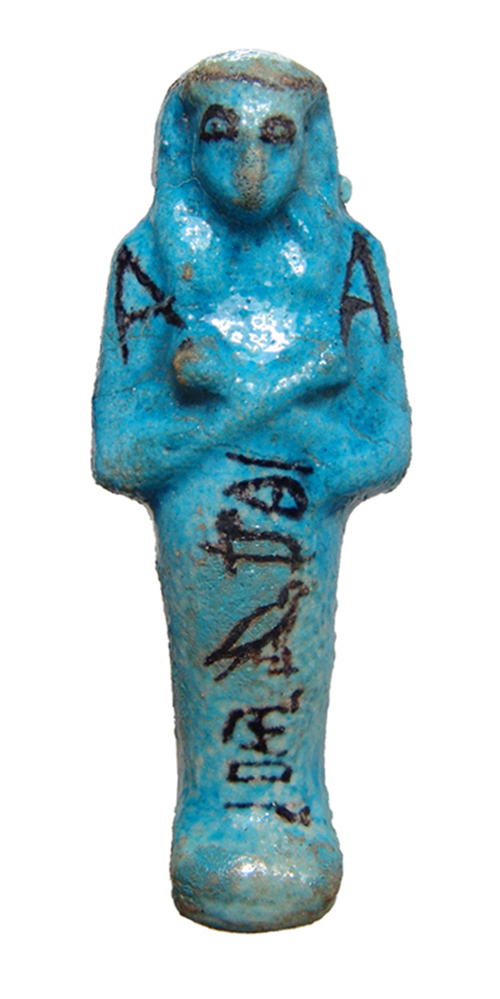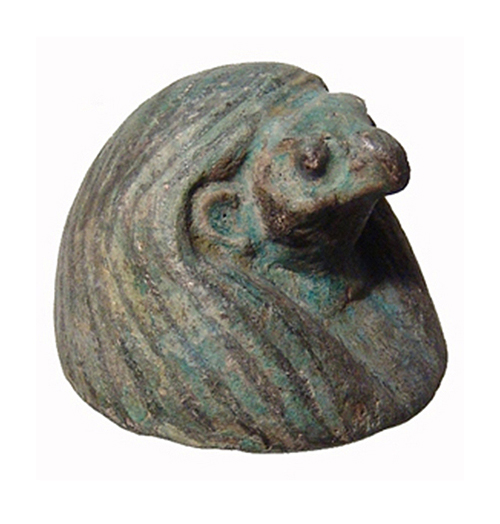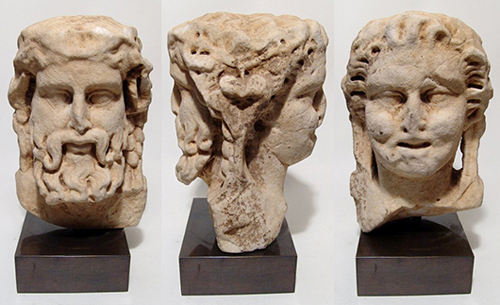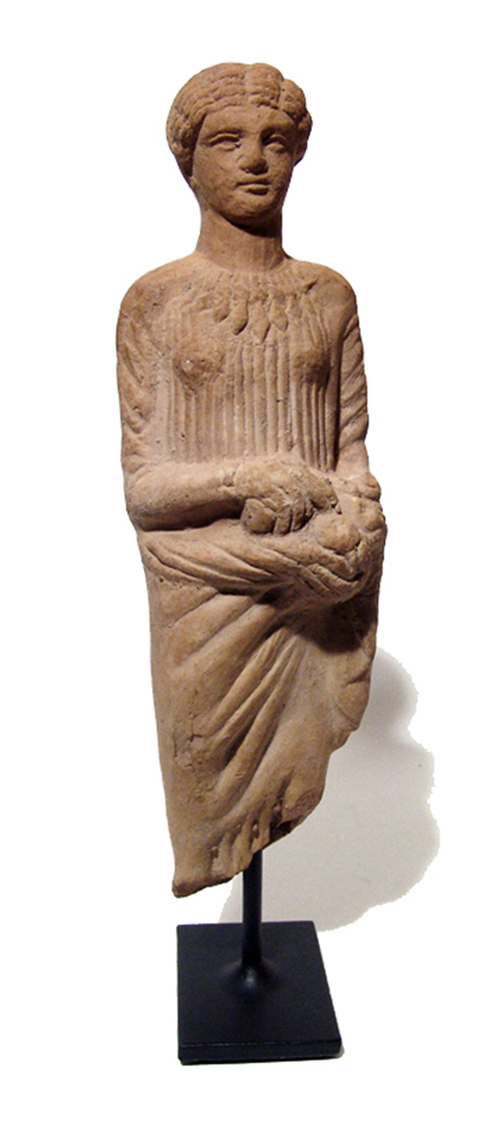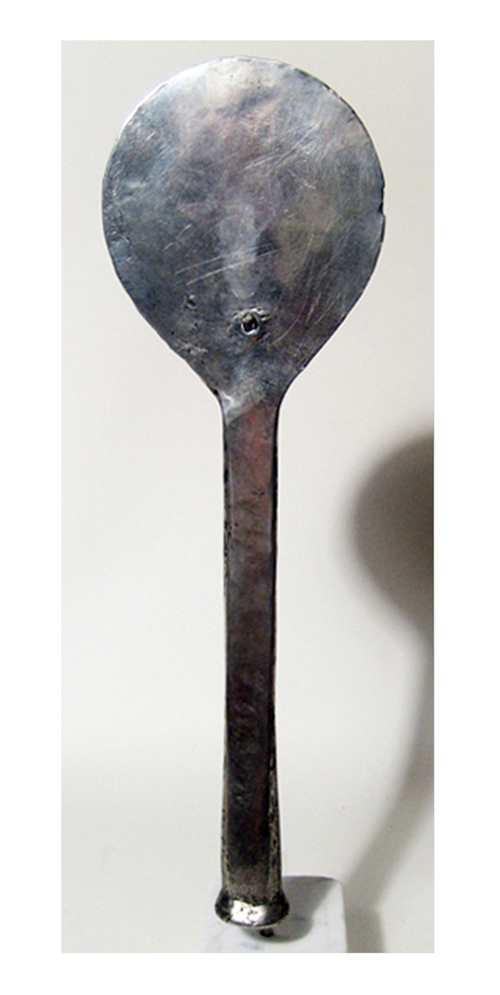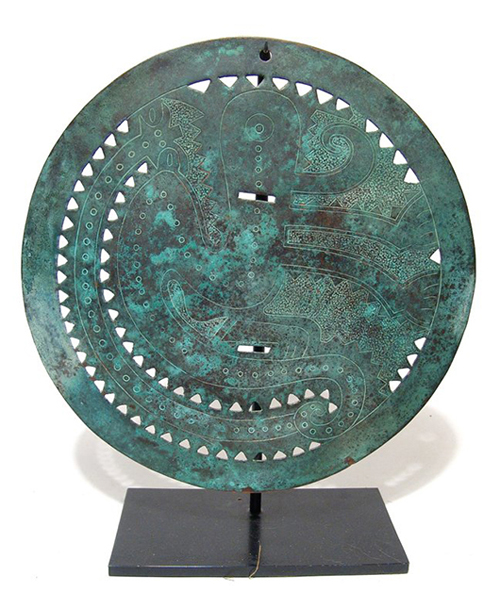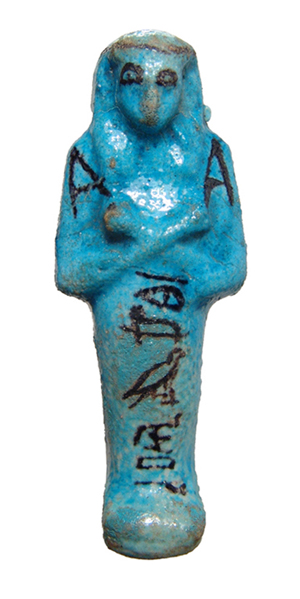
Egyptian bicolor faience ushabti, 3rd Intermediate Period, 21st Dynasty, c. 1075 – 945 BC. Ex English private collection. Ancient Resource image.
LOS ANGELES – Ancient Resource, LLC will present an exciting array of ancient art in its April 6th auction, with Internet live bidding through LiveAuctioneers.com. The auction contains more than 360 lots of well-provenanced goods representing a range of cultures, from the exceptionally rare Babylonian through Egyptian Greek and Roman, to all of the diverse peoples of the New World.
The market for antiquities continues to soar as better pieces enter the realm of tangible assets. Many view antiquities as a viable hedge against inflation and the declining dollar. Provenance is important in this category, and the bulk of Ancient Resource’s selections come from select US estates and European collections assembled during the late 19th and early 20th century.
The 21st Dynasty marked the height of the Egyptian development of blue glazed faience. Glazed in this deep rich color, faience was perceived as substitute for blue-green materials such as turquoise, found in the Sinai peninsula, and lapis lazuli, from Afghanistan. The symbolism embedded in blue glazing could recall both the Nile, the waters of heaven and the home of the gods. A prized Egyptian bicolor faience ushabti, entered as Lot 59, epitomizes the quality of the Third Intermediate Period, 21st Dynasty, circa 1075 – 945 BC. A mummiform wearing a tripartite wig with seshed head-band, its arms are folded over its chest, each hand holding a hoe, with a bag on the back and a column of text down front. It has a 19th century label on verso and was formerly in an English private collection.
The vast majority of canopic jars were produced in limestone or pottery. In the Third Intermediate Period and later, dummy canopic jars were introduced. Improved embalming techniques allowed the viscera to remain in the body. The traditional jars remained a feature of tombs but were no longer hollowed out for storage of the organs. This change allowed for the production of magnificent jars in faience. A highly unusual example is Lot 108. A choice bi-color faience canopic lid in the form of Qebehsenuef, Third Intermediate Period, c. 1075 – 665 BC, it represents a falcon-headed deity that is one of the “Four Sons of Horus.” The jar lid is beautiful detailed with dark blue lines in the striated wig and has black cosmetic details all over the bright turquoise base. It was formerly in a New York City private collection.
The first of January was dedicated by the Romans to their God of Gates and Doors, Janus. He is commonly depicted with two faces…one regarding what is behind and the other looking toward what lies ahead. Thus, Janus symbolizes contemplation of the happenings of an old year while looking forward to the new. Some sources claim that Janus was characterized in such a peculiar fashion due to the notion that doors and gates look in two directions. Therefore, the God could look both backward and forward at the same time. Originally, Janus was portrayed with one bearded face and the other clean-shaven, which may have symbolized the moon and the sun, or age and youth. Lot 124 continues that theme but uses Dionysos as a subject.
The Roman marble janiform herm, 1st-2nd century AD, depicts on one side Dionysos with a curled beard and moustache, wearing a foliate wreath with vines to either side of his head. The opposite side depicts a youthful satyr with short curly hair, his eyes wide and his mouth slightly open. Mounted on a custom base, it comes to auction with provenance from Charles Ede Ltd, London 1988; a German private collection, and subsequent prchase from Christie’s on Oct. 18, 2005.
Terra-cotta figures of women bearing gifts were quite popular in Ancient Greece. The great majority of the figurines simply represent a woman upright, without attribute. These latter figurines were offered in all sanctuaries, independently of the divinity. The terracotta figurines were often purchased at the entry of the sanctuary and placed on temple benches or next to the cult god. They were used to replace offerings in kind, like animals or food. Lot 172 is a beautiful example of a female offering this type of gift.
The Greek terra-cotta figure of a woman, circa 5th century BC, wears chiton and himation, her necklace featuring large diamond-shape pendant beads. In her arms she clutches what appear to be apples. Her facial expression is calm and serene, and her hair is styled back in ridges. There are some losses to the figure’s feet, but it is an attractive piece mounted on a custom metal base. Ex English private collection, acquired prior to 1980.
The Inca made beautiful objects of gold, silver, copper, bronze and tumbago. But precious metals were in shorter supply than in earlier Peruvian cultures so surviving works in silver are quite rare. The Inca metalworking style draws much of its inspiration from Chimu art and in fact the best metal workers of Chan Chan were transferred to Cusco when the Kingdom of Chimor was incorporated into the empire. The metalworks of the Incas were perhaps the most advanced in America. When the Spanish encountered the Inca people, most of their silver and gold goods were melted down for bullion. Ancient Resource is particularly proud to offer Lot 352, a late Inca heavy pure silver mirror, Peru, circa 1000-1450 AD. Of solid construction, its handle has a rectangular profile and rounded base, the rounded end is pounded flat and polished, and there is a central hole, perhaps for suspension or for a decorative applique. Ex Collection of Marjorie and Charles Benton, Evanston, Illinois.
The Chimu people were master metalsmiths. Although copper is found naturally on the coast, it was mostly attained from the highlands in an area about three days away. Since most of the copper was imported, it is likely that most of the metal objects that were made were very small. The pieces, such as wires, needles, digging stick points, tweezers, and personal ornaments, are consistently utilitarian objects of copper or copper bronze. That said, Lot 346 in the sale is quite unusual for a Chimu bronze piece.
A choice Chimu incised bronze disk from Peru, circa 1100-1450 AD, it depicts a stylized reptile with sharp teeth and a long, curving tail. The incising is accentuated with triangular and rectangular cut-outs, with a suspension hole at the top. Mounted on a custom base, it comes from the Collection of Marjorie and Charles Benton, Evanston, Illinois.
For additional information on any item in Ancient Resource’s April 6 auction, call 818-425-9633 or e-mail gabriel@ancientresource.com.
View the fully illustrated catalog and sign up to bid absentee or live via the Internet at www.LiveAuctioneers.com.
# # #
ADDITIONAL LOTS OF NOTE
Egyptian bicolor faience ushabti, 3rd Intermediate Period, 21st Dynasty, c. 1075 – 945 BC. Ex English private collection. Ancient Resource image. Bi-color faience canopic lid in the form of Qebehsenuef, 3rd Intermediate Period, c. 1075 – 665 BC. Ex New York City private collection. Ancient Resource image. Roman marble janiform herm, 1st – 2nd Century AD, one side depicting Dionysos and the other depicting a youthful satyr. Ex Charles Ede Ltd, London 1988; ex German private collection, acquired from Christie’s, 18 Oct. 2005. Ancient Resource image. Greek terra-cotta figure of a woman, circa 5th Century BC, wearing chiton and himation; necklace with large diamond-shaped pendant beads. Ex English private collection, acquired prior to 1980. Ancient Resource image. Late Inca heavy pure silver mirror, Peru, c. AD 1000 – 1450, heavy and of solid construction. From the collection of Marjorie and Charles Benton, Evanston, Illinois. Ancient Resource image. Chimu incised bronze disk, Peru, c. AD 1100 – 1450, depicting a stylized reptile with sharp teeth and a long, curving tail. From the collection of Marjorie and Charles Benton, Evanston, Illinois. Ancient Resource image.